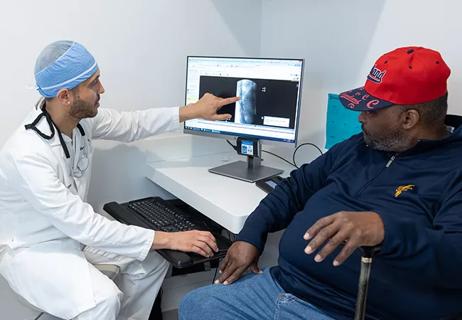Maternal-fetal medicine specialists, endocrinologists and educators team up

The best time for patients with diabetes to talk to their physicians about family planning is well before they become pregnant, but that doesn’t always happen. Two new Cleveland Clinic programs aim to care for the distinct needs of patients who have diabetes and want to become pregnant or who have diabetes during pregnancy. These programs also educate patients, residents, fellows and medical students about the importance of preparation for pregnancy and close monitoring during pregnancy.
Advertisement
Cleveland Clinic is a non-profit academic medical center. Advertising on our site helps support our mission. We do not endorse non-Cleveland Clinic products or services. Policy
Maternal-fetal medicine specialists Stacey Ehrenberg, MD, and Cara Dolin, MD, and endocrinologist Neeharika Nandam, MD, lead the Diabetes and Pregnancy programs, where clinicians who share a passionate interest in this patient population have set up systems to address their needs.
“As high-risk obstetricians, our goal with these programs is to optimize care for patients with diabetes before and during pregnancy,” says Dr. Ehrenberg. “There are many comorbidities in pregnancy where all we can offer is treating symptoms and managing complications when they arise. However, with diabetes, if we meet a patient before conception, we can help them come into pregnancy healthier, which leads to healthier pregnancies.”
Dr. Nandam agrees, noting the critical role glucose control plays at the inception of pregnancy.
“A very common issue that we run into is women with diabetes who are experiencing infertility or pregnancy loss,” she says. “A lot of times those problems are related to difficulties with controlling their diabetes.”
According to the Centers for Disease Control and Prevention, 1% to 2% of women have type 1 or type 2 diabetes during their pregnancy. An additional 6% to 9% develop gestational diabetes. Numbers have been rising in recent decades.
For patients with pregestational diabetes, the protocols during pregnancy change considerably.
“For non-pregnant patients who have type 1 or type 2 diabetes, if their fasting blood sugars are between 100 mg/dL and 126 mg/dL, their provider is probably thrilled. They usually like their blood sugars throughout the day to be under about 180 mg/dL, and if they’re under 200 mg/dL, they’re probably happy,” says Dr. Ehrenberg. “However, our goals in pregnancy are fasting blood sugars under 95 mg/dL, and the highest we want their blood sugars to be is 139 mg/dL. Tighter glycemic control during pregnancy leads to healthier pregnancies. A lot of women aren’t used to so tightly controlling their blood sugar.”
Advertisement
Educating and coaching patients, as well as reviewing and adjusting diabetes medications, are just a part of what the Diabetes and Pregnancy clinics do.
The new programs focus on patients with different types of diabetes. One is for patients with pregestational diabetes – either type 1 or 2. The second is for those with gestational diabetes. Both provide access to a maternal-fetal medicine specialist, dietitian and a clinical pharmacist who serves as a diabetes educator and has expertise in glucose control technologies.
“All of the patients see all of these clinicians at one time, in one place,” says Dr. Ehrenberg. “We all work very closely together, literally sitting next to each other in the office or in a virtual space so that patient care is seamless.”
The program for patients with gestational diabetes lives online, through shared medical appointments (SMA).
“Typically, women with gestational diabetes come in for a one-on-one consult with a maternal-fetal medicine specialist, and then on a different day would see a dietitian and a diabetes educator,” says Dr. Ehrenberg. “That requires multiple visits on multiple days. Our virtual program is innovative in that it allows patients to participate from wherever they are. There has been a lot of positive data on doing group care for patients with diabetes outside of pregnancy. And the data is amazing. When patients are seen in a group, their hemoglobin A1Cs tend to be better and they feel better supported.”
The virtual visits are creating efficiencies for patients and providers.
Advertisement
“The gestational diabetes program is on Thursday mornings virtually, and we’re able to see up to 10 patients in two and a half hours,” says Dr. Ehrenberg. “Typically, 10 in-person consults could take up to 10 hours, which is more than a full workday for each provider. We are accomplishing that in two and a half hours total for all three providers.”
The camaraderie that takes hold during the SMAs can be especially helpful for patients with gestational diabetes, says Dr. Dolin.
“Patients really love the shared medical appointment because often they get this diagnosis of gestational diabetes out of nowhere, and they feel like it’s their fault,” she says. “They wonder what they did to cause it, and adjusting to the diagnosis can feel as if they have a full-time job. They suddenly must think about everything they eat and check their sugars multiple times throughout the day. So then when they’re in that group visit with nine other patients who are all going through the same thing, that shared experience is really helpful for them.”
The pre-gestational diabetes program is a live, in-person program where patients with type 1 or type 2 diabetes present for an initial visit with a maternal-fetal medicine physician, a clinical pharmacist/diabetes education specialist and a dietician. Patients learn about risks during pregnancy, plan for the pregnancy, discuss medication, nutrition and the best way to monitor their glucose levels through different types of technology. Glucose levels are then followed weekly by the team, and medication adjustments are made as needed. In addition, patients who desire pregnancy can come to the clinic before they are pregnant for close monitoring and more frequent medication adjustments to optimize their diabetes prior to conception.
Advertisement
The program also has a research arm to help advance the care of women with diabetes and pregnancy, as well as an outreach effort to involve patients in the community.
From an endocrinology perspective, Dr. Nandam says the need for such programs is acute –especially in geographic locations with limited health resources.
“There are so many women who have type 1 and type 2 diabetes who usually see their endocrinologists on a once-a-year basis or every six months. Or they may not have an endocrinologist at all, depending on where they live,” she says. “Their only medical care may be through the primary care doctor they see once a year. Once a person with diabetes becomes pregnant, they need to be seen very frequently, but they may not have those resources in their area. That is the need that we’re trying to fill.”
Her principal areas of focus are caring for patients with complex disease and helping patients optimize their glucose control before they become pregnant. She also sees patients for their first postpartum endocrinology appointment. Concerns might include controlling glucose during breastfeeding and transitioning patients back to their regular diabetes medications if they had used an alternative while they were pregnant. Her goal, she says, is “to ensure a seamless medical transition into and out of pregnancy.”
Among the biggest challenges of the program is persuading women to connect with their providers before becoming pregnant.
“Pregnancy is an optimal time to educate patients because they’re so motivated,” says Dr. Ehrenberg. “They understand that their choices directly impact their baby. Outside of pregnancy, we find it much more challenging – first, to get them to come in, and second, to comply with recommendations. Women are busy, and a lot of them have careers and other children. It can be a very hard concept for people to accept – that doing something now will make things better down the road.”
Advertisement
Getting the word out among their peers in primary care is an important part of changing that trend.
Other challenges:
Finding space. Cleveland Clinic’s pregestational diabetes program found a home at Cleveland Clinic Hillcrest Hospital and the Middleburg Heights Family Health Center, and is always filled. The virtual program for patients with gestational diabetes is easier to accommodate, although occasionally a patient will not have appropriate technology to take part.
Scheduling. Scheduling SMAs can be complicated, because 10 patients are involved on a given day. There can be a learning curve for the scheduling assistants who perform this task.
Billing. Care must be taken to ensure that billing for group-care visits and individual-care visits are done correctly.
Assembling the right team. A successful diabetes and pregnancy program benefits when all team members are passionately interested in this field, says Dr. Ehrenberg.
“I graduated fellowship a little over 10 years ago, and I’ve always focused on diabetes and pregnancy,” says Dr. Ehrenberg. “That has always been an area of interest, and I have never worked with another partner who has been so passionate and focused on collaborating on diabetes as Dr. Dolin. And then we’ve been very fortunate to find clinical pharmacists, diabetes educators, dieticians and endocrinologists who are equally passionate about caring for women with diabetes and pregnancy. These programs would not be what they are today without this amazing group of health care providers.”
Advertisement

Association revises criteria for the diagnosis and resolution of severe conditions

Less than 50% of patients with diabetes get appropriate ophthalmic screening through primary care referrals

Familiarity will enhance its accessibility for patients with diabetes

New study counters earlier findings linking drugs with eye disease

Study highlights the value of quantitative ultra-widefield angiography

Longevity in healthcare, personal experiences may provide caregivers with false sense of confidence

Spinal cord stimulation can help those who are optimized for success

Cleveland Clinic’s Endocrinology & Metabolism Institute is working to offer novel opportunities and therapies for diabetes and kidney disease